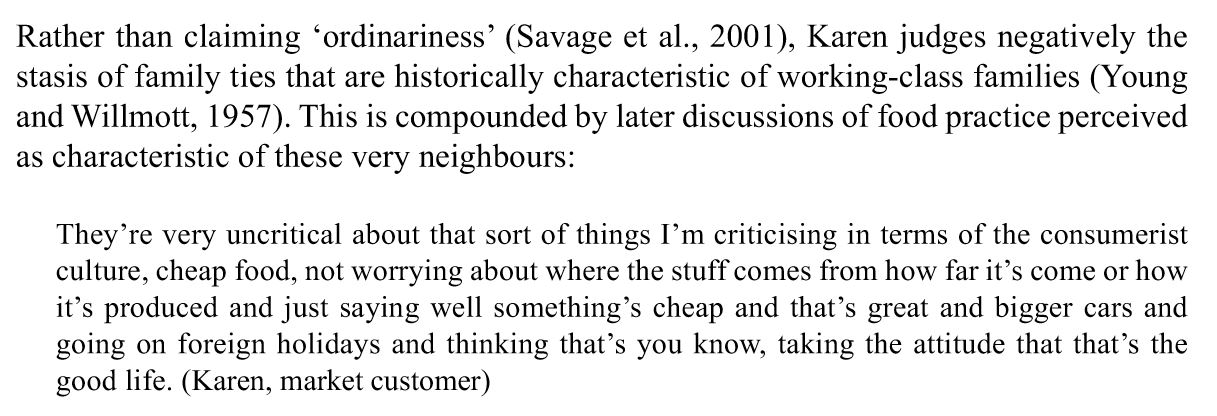This week, we revisited the two papers which were introduced in Week 4. As we move into considering data analysis, we were asked to consider a number of questions about each of them. The first paper, by Paddock, is an account of a qualitative study into food cultures and class.
Paper 1: Paddock, J. 2016. Positioning Food Cultures: ‘Alternative’ Food as Distinctive Consumer Practice. Sociology. 50(6). Available: http://journals.sagepub.com/doi/full/10.1177/0038038515585474
Questions for discussion:
- Why do you think Paddock chose narratives as a way of conveying the main themes in her research?
One key strand in Paddock’s research is the relationality of class position as articulated through attitudes to food generally and to the farmer’s market and local food co-op specifically. By transcribing extracts from participants’ narratives, she is able to convey insights into the complex ways in which individuals articulate their sense of group membership and class partly through defining themselves in relation to a perceived ‘other’. - What is the impact for you of the way the interview talk is presented? What is the point of the researcher noting points of laughter, for example? What about filler sounds like ‘erm’?
For me, these details in the transcript serve to convey both tone (e.g., the noting of laughter) and also a sense of the ‘authenticity’ of the narratives. The inclusion of fillers convey the sense that the participants are thinking about their responses – recalling, constructing and trying to convey an articulation of their position. What can’t, readily, be conveyed are all of the other communicative signs, such as gesture and eye contact. - How does Paddock go about building a case for the interpretations she is making? How does she compel you, as a reader, to take her findings seriously? Share a specific example of how you think this is done in this article.
For me, Paddock’s use of a framework of other research adds credibility to her findings. Her argument builds upon those proposed by a wide range of research. The scope of her literature review is one of the ways in which she compels us to take her argument seriously:
p.1042 The selection of her narrative exemplars also supports her arguments:
- Interviewees use many emotive words in the excerpts presented here, but Paddock has focused in on the use of the word ‘disgusting’, and developed this through her analysis. How does this concept help her link the data with her theoretical perspective?
Aligning herself with a number of commentators (Bourdieu, Lamont and Southerton), Paddock claims that class identity is established through boundary marking, through a definition of ‘us’ as opposed to ‘them’ (Paddock, 2016, p.1048). This is, for alternative food movements, problematic as potentially useful and progressive schemes to improve food-acquisition habits have become defined by some groups as not for ‘them’ but for ‘others’. There is a cultural disjunct which can prevent some from feeling that practices are ‘for them’; barriers to adoption of new consumer habits are not only economic. The word ‘disgusting’ is one which is used by one of the ‘FM’ – Farmers’ Market – participants. She claims that ‘everybody’ in a deprived area felt this way about breast-feeding. This attribution of disgust to the ‘other’ and the implied sense of disgust about choices made by a perceived ‘under-proletariat’ serves to illustrate how those who consider themselves to be middle-classes distinguish themselves and their ‘good’ choices from the ‘others’ who make ‘bad’ ones. - Paddock’s main argument is that food is an expression of social class. Looking just at the interview excerpts presented here, what other ideas or research questions do you think a researcher could explore?
Paddock has gone some way towards this, but an examination of perceptions as to what constitutes ‘good’ and ‘bad’ consumption would be of interest. Another rich seam would be to explore what signs and signals in a seemingly public, open space, signal that you belong or not.


